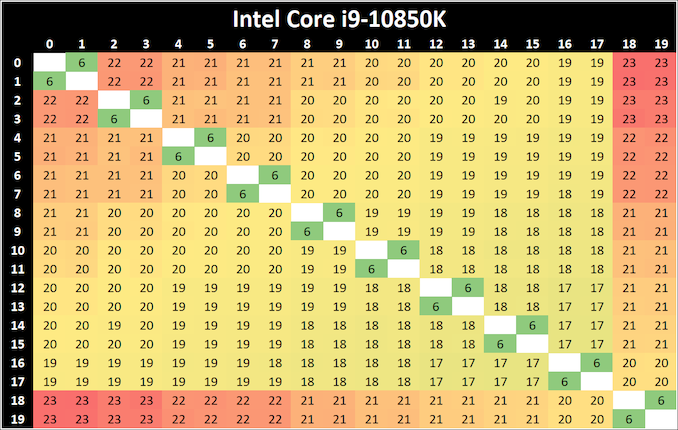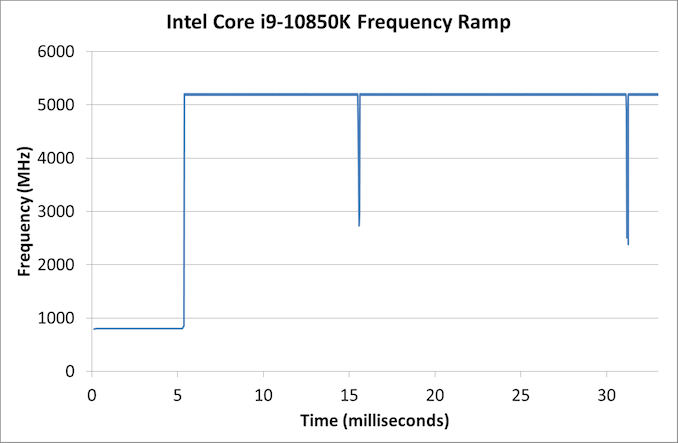Intel Core i9-10850K Review: The Real Intel Flagship
by Dr. Ian Cutress on January 4, 2021 9:00 AM EST- Posted in
- CPUs
- Intel
- Core
- Z490
- 10th Gen Core
- Comet Lake
- LGA1200
- i9-10850K
CPU Tests: Microbenchmarks
Core-to-Core Latency
As the core count of modern CPUs is growing, we are reaching a time when the time to access each core from a different core is no longer a constant. Even before the advent of heterogeneous SoC designs, processors built on large rings or meshes can have different latencies to access the nearest core compared to the furthest core. This rings true especially in multi-socket server environments.
But modern CPUs, even desktop and consumer CPUs, can have variable access latency to get to another core. For example, in the first generation Threadripper CPUs, we had four chips on the package, each with 8 threads, and each with a different core-to-core latency depending on if it was on-die or off-die. This gets more complex with products like Lakefield, which has two different communication buses depending on which core is talking to which.
If you are a regular reader of AnandTech’s CPU reviews, you will recognize our Core-to-Core latency test. It’s a great way to show exactly how groups of cores are laid out on the silicon. This is a custom in-house test built by Andrei, and we know there are competing tests out there, but we feel ours is the most accurate to how quick an access between two cores can happen.
When we first reviewed the 10-core Comet Lake processors, we noticed that a core (or two) seemed to take slightly longer to ping/pong than the others. We see the same pattern here again with the final core.
Frequency Ramping
Both AMD and Intel over the past few years have introduced features to their processors that speed up the time from when a CPU moves from idle into a high powered state. The effect of this means that users can get peak performance quicker, but the biggest knock-on effect for this is with battery life in mobile devices, especially if a system can turbo up quick and turbo down quick, ensuring that it stays in the lowest and most efficient power state for as long as possible.
Intel’s technology is called SpeedShift, although SpeedShift was not enabled until Skylake.
One of the issues though with this technology is that sometimes the adjustments in frequency can be so fast, software cannot detect them. If the frequency is changing on the order of microseconds, but your software is only probing frequency in milliseconds (or seconds), then quick changes will be missed. Not only that, as an observer probing the frequency, you could be affecting the actual turbo performance. When the CPU is changing frequency, it essentially has to pause all compute while it aligns the frequency rate of the whole core.
We wrote an extensive review analysis piece on this, called ‘Reaching for Turbo: Aligning Perception with AMD’s Frequency Metrics’, due to an issue where users were not observing the peak turbo speeds for AMD’s processors.
We got around the issue by making the frequency probing the workload causing the turbo. The software is able to detect frequency adjustments on a microsecond scale, so we can see how well a system can get to those boost frequencies. Our Frequency Ramp tool has already been in use in a number of reviews.
The Core i9-10850K ramps up extremely quickly from idle to peak turbo, in the region of about 5 milliseconds. This is faster than the 16 ms we typically observe.












126 Comments
View All Comments
zodiacfml - Monday, January 4, 2021 - link
While it is true that AMD's current available Ryzen mobile at 7nm is superior to the M1 at 5nm, you have to consider that M1 is Apple's entry level. Things will get more interesting once AMD gets into 5nm and Apple releases bigger M1Alistair - Monday, January 4, 2021 - link
That is not true at all. Everything works on the M1, I have an M1 Mac Mini and a PC and have no problems. The issue is Apple's lack of expansion and lack of GPU performance. Games for example that are not on the Mac, not because of M1's performance (which is excellent) but because of M1's lack of GPU performance vs a basic video card, and the lack of the basic GPU expansion options. Also Mac OS sucks compared to Windows imo, but the Mac Mini hardware and M1 CPU performance are A+. Hopefully Apple doubles the GPU options and performance quickly.Meteor2 - Thursday, January 7, 2021 - link
Yes, I thought that a very strange statement too. Rosetta2 exists and it works.JayNor - Monday, January 4, 2021 - link
compared to the competition that can't respond to the WFH and educational demand?Qasar - Tuesday, January 5, 2021 - link
still better then a company that fell asleep, and stagnated the cpu industry. intels lack of innovation, and reliance on its process tech, is what has caused intel to be in the position it is now in.powerarmour - Tuesday, January 5, 2021 - link
Can you actually buy an Intel motherboard at the moment?, shortages are very apparent there too.regsEx - Thursday, January 7, 2021 - link
Apple doesn't have any high performance CPU.JessNarmo - Monday, January 4, 2021 - link
420mm AIO with bare die liquid metal here we come!But jokes aside good 360 AIO with liquid metal should keep it quite easily under 80C at all times.
Anytime you see significant temperatures liquid metal helps disproportionately more, because it's thermal conductivity grows with temperature unlike thermal pastes. It drops 20C from 80C on paste and 30C from 100C on paste.
Still I'd rather wait for 5900x
Deicidium369 - Monday, January 4, 2021 - link
Did you see the cooler?http://thermalright.com/product/true-copper/
passive design
lopri - Monday, January 4, 2021 - link
I have been looking for that cooler. Does anyone know where to find one?